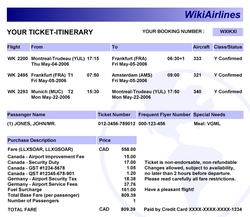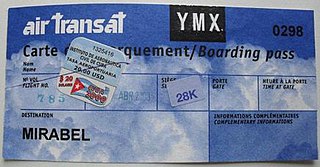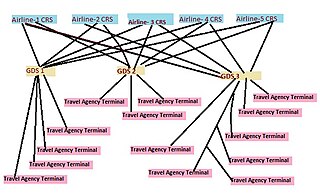
An electronic ticket is a method of ticket entry, processing, and marketing for companies in the airline, railways and other transport and entertainment industries.

An electronic ticket is a method of ticket entry, processing, and marketing for companies in the airline, railways and other transport and entertainment industries.
E-tickets in the airline industry were devised in about 1994, [1] and have now largely replaced the older multi-layered paper ticketing systems. Since 1 June 2008, it has been mandatory for IATA members to use e-ticketing. Where paper tickets are still available, some airlines charge a fee for issuing paper tickets.
When a reservation is confirmed, the airline keeps a record of the booking in its computer reservations system. Customers can print out or may be provided with a copy of a e-ticket itinerary receipt which contains the record locator or reservation number and the e-ticket number. It is possible to print multiple copies of an e-ticket itinerary receipt.
Besides providing itinerary details, an e-ticket itinerary receipt also contains:
Passengers with e-tickets are required to check-in at the airport for a flight in the usual manner, except that they may be required to present an e-ticket itinerary receipt or personal identification, such as a passport, or credit card. They can also use the Record locator, often called booking reference, a code of six letters and digits. Producing a print-out of an e-ticket itinerary receipt may be required to enter the terminal of some airports or to satisfy immigration regulations in some countries.[ citation needed ]
The introduction of e-tickets has allowed for various enhancements to checking-in processes.
Several websites assist people holding e-tickets to check in online in advance of the twenty-four-hour airline restriction. These sites store a passenger's flight information and then when the airline opens up for online check-in the data is transferred to the airline and the boarding pass is emailed back to the customer. With this e-ticket technology, if a passenger receives his boarding pass remotely and is travelling without check-in luggage, he may bypass traditional counter check-in.
The ticketing systems of most airlines are only able to produce e-tickets for itineraries of no more than 16 segments, including surface segments. This is the same limit that applied to paper tickets.
Another critical limitation is that at the time e-tickets were initially designed, most airlines still practiced product bundling. By the time the industry began 100% e-ticket implementation, more and more airlines began to unbundle previously included services (like checked baggage) and add them back in as optional fees (ancillary revenue). However, the e-ticket standard did not anticipate and did not include a standardized mechanism for such optional fees.
IATA later implemented the Electronic Miscellaneous Document (EMD) standard for such information. This way, airlines could consistently expose and capture such fees at time of booking through travel reservation systems, rather than having to surprise passengers with them at check-in.
As part of the IATA Simplifying the Business initiative, the association instituted a program to switch the industry to 100% electronic ticketing. The program concluded on June 1, 2008, with the association saying that the resulting industry savings were approximately US$3 billion. [3]
In 2004, IATA Board of Governors set the end of 2007 as the deadline for airlines to make the transition to 100% electronic ticketing for tickets processed through the IATA billing and settlement plan; [4] in June 2007, the deadline was extended to May 31, 2008. [5]
As of June 1, 2008 paper tickets can no longer be issued on neutral stock by agencies reporting to their local BSP. Agents reporting to the ARC using company-provided stock or issuing tickets on behalf of an airline (GSAs and ticketing offices) are not subject to that restriction.
The industry was unable to comply with the IATA mandate and paper tickets remain in circulation as of February 2009.[ citation needed ]
Amtrak started offering electronic tickets on all train routes on 30 July 2012. [6] These tickets can be ordered over the internet and printed (as a PDF file), printed at a Quik-Trak kiosk, or at the ticket counter at the station. Electronic tickets can also be held in a smart phone and shown to the conductor using an app. Mobile tickets are common with operators of US commuter train networks (e.g. MTA LIRR and Metro North) but they are usually only offered on the US version of the App Store and only accept US-issued credit cards as the app's payment page asks the user for the credit card's ZIP code to complete the purchase.
Several European train operators also offer self-printable or downloadable tickets. Often tickets can also be delivered by SMS or MMS. Railway operators in other countries also issue electronic tickets. The national operators of Denmark and Netherlands have a nationwide system where RFID smartcards are used as train tickets. In the UK, the issuance of printable or mobile tickets is at the discretion of train operators and is often available for advance tickets only (i.e. valid only on a specific train). This is very common in Europe for local urban rail, such as rapid transit/metros.[ citation needed ] During the 2010:s phone apps have been increasingly popular. Passengers do not have to visit a machine or a desk to buy a ticket or refill an RFID card, but can buy it in their phone.
In India, an SMS sent by the Indian Railways, along with a valid proof of identity is considered equivalent to a ticket. [7]
Many sport, concert venues, and cinemas use electronic ticketing for their events. Electronic tickets, or "eTickets" as they are sometimes referred, are often delivered as PDFs or another downloadable format that can be received via email or through a mobile app. Electronic tickets allow organizers to avoid the cost of producing and distributing physical tickets by transferring costs to the customer, who must own electronic hardware and purchase internet access in order to receive their ticket.
A printed copy of these tickets or a digital copy on a mobile phone should be presented on coming to the venue. These tickets now normally also have a barcode, which may be scanned on entry into the venue to streamline crowd processing. Electronic tickets have become increasingly prevalent in the entertainment industry over the last decade.
In some cases, spectators who want to see a match may not need a printable electronic ticket. If someone with a membership to a football team books a ticket online, the member can just verify his/her reservation with a membership card at the entrance. This is common with teams in the English Premiership League.
| | This section needs expansion. You can help by adding to it. (January 2017) |
In January 2017 it was reported that Germany's Federal Minister of Transport and Digital Infrastructure, Alexander Dobrindt wants to create an electronic ticket to connect public bus and train services as well as parking spaces and potentially car-sharing services across all cities. [8] [9] [ needs update ] A nationwide electronic ticket system was introduced in Denmark in 2010, called Rejsekort.
National Rail (NR) is the trading name licensed for use by the Rail Delivery Group, an unincorporated association whose membership consists of the passenger train operating companies (TOCs) of England, Scotland, and Wales. The TOCs run the passenger services previously provided by the British Railways Board, from 1965 using the brand name British Rail. Northern Ireland, which is bordered by the Republic of Ireland, has a different system. National Rail services share a ticketing structure and inter-availability that generally do not extend to services which were not part of British Rail.
Suica is a prepaid rechargeable contactless smart card, electronic money used as a fare card on train lines in Japan, launched on November 18, 2001. The card can be used interchangeably with JR West's ICOCA in the Kansai region and San'yō region in Okayama, Hiroshima, and Yamaguchi prefectures, and also with JR Central's TOICA, JR Kyushu's SUGOCA, Nishitetsu's Nimoca, and Fukuoka City Subway's Hayakaken area in Fukuoka City and its suburb areas. The card is also increasingly being accepted as a form of electronic money for purchases at stores and kiosks, especially within train stations. As of 2018, JR East reports 69.4 million Suica UID's have been issued, usable at 476,300 point of sale locations, with 6.6 million daily transactions.
A passenger name record (PNR) is a record in the database of a computer reservation system (CRS) that contains the itinerary for a passenger or a group of passengers travelling together. The concept of a PNR was first introduced by airlines that needed to exchange reservation information in case passengers required flights of multiple airlines to reach their destination ("interlining"). For this purpose, IATA and ATA have defined standards for interline messaging of PNR and other data through the "ATA/IATA Reservations Interline Message Procedures - Passenger" (AIRIMP). There is no general industry standard for the layout and content of a PNR. In practice, each CRS or hosting system has its own proprietary standards, although common industry needs, including the need to map PNR data easily to AIRIMP messages, has resulted in many general similarities in data content and format between all of the major systems.

A boarding pass or boarding card is a document provided by an airline during airport check-in, giving a passenger permission to enter the restricted area of an airport and to board the airplane for a particular flight. At a minimum, it identifies the passenger, the flight number, the date, and scheduled time for departure. A boarding pass may also indicate details of the perks a passenger is entitled to and is thus presented at the entrance of such facilities to show eligibility.

An open-jaw ticket is an airline return ticket where the destination and/or the origin are not the same in both directions. The name is derived from how it looks when drawn on a map.

Bag tags, also known as baggage tags, baggage checks or luggage tickets, have traditionally been used by bus, train, and airline carriers to route checked luggage to its final destination. The passenger stub is typically handed to the passenger or attached to the ticket envelope:

Check-in is the process whereby people announce their arrival at an office, hotel, airport, hospital, seaport or event.
This is a list of airline codes. The table lists IATA's two-character airline designators, ICAO's three-character airline designators and the airline call signs. Historical assignments are also included.

A global distribution system (GDS) is a computerised network system owned or operated by a company that enables transactions between travel industry service providers, mainly airlines, hotels, car rental companies, and travel agencies. The GDS mainly uses real-time inventory from the service providers. Travel agencies traditionally relied on GDS for services, products and rates in order to provide travel-related services to the end consumers. Thus, a GDS can link services, rates and bookings consolidating products and services across all three travel sectors: i.e., airline reservations, hotel reservations, car rentals.
Overselling or overbooking is sale of a volatile good or service in excess of actual supply. Overselling is a common practice in the travel and hospitality sectors, in which it is expected that some people will cancel. The practice occurs as an intentional business strategy in which sellers expect that some buyers will not consume all of the resources they are entitled to, or that some buyers will cancel. The practice of overselling aims to ensure that 100% of available supply will be used, resulting in the maximum return on investment. However, if more customers than the seller expects do wish to purchase or use the sold commodity, it may leave some customers lacking a service they expected to receive.
An air waybill (AWB) or air consignment note is a receipt issued by an international airline for goods and an evidence of the contract of carriage. It is not a document of title to the goods. The air waybill is non-negotiable.

Avantix Mobile ("AVB") is a portable railway ticket issuing system used across the British railway network from 2001 to 2017.

Airport check-in is the process whereby an airline approves airplane passengers to board an airplane for a flight. Airlines typically use service counters found at airports for this process, and the check-in is normally handled by an airline itself or a handling agent working on behalf of an airline. Passengers usually hand over any baggage that they do not wish or are not allowed to carry in the aircraft's cabin and receive a boarding pass before they can proceed to board their aircraft.
Interlining, also known as interline ticketing and interline booking, is a voluntary commercial agreement between individual airlines to handle passengers traveling on itineraries that require multiple flights on multiple airlines. Such agreements allow passengers to change from one flight on one airline to another flight on another airline without having to gather their bags or check-in again. Airlines can also promise free rebooking if the connection is lost due to a delay.

An airline ticket is a document or electronic record, issued by an airline or a travel agency, that confirms that an individual is entitled to a seat on a flight on an aircraft. The airline ticket may be one of two types: a paper ticket, which comprises coupons or vouchers; and an electronic ticket.
Airline reservation systems (ARS) are systems that allow an airline to sell their inventory (seats). It contains information on schedules and fares and contains a database of reservations and of tickets issued. ARSs are part of passenger service systems (PSS), which are applications supporting the direct contact with the passenger.
Alternate air ticket purchasing order systems allow for alternative ways of purchasing air tickets and GDS Connectivity not involving Internet or personal TA contact.

A train ticket is a transit pass ticket issued by a railwayoperator that enables the bearer to travel on the operator's network or a partner's network. Tickets can authorize the bearer to travel a set itinerary at a specific time, a set itinerary at any time, a set itinerary at multiple times, or an arbitrary itinerary at specific times. The last two categories are often called passes: the former is often sold as a discounted block of trips for commuters; the latter is often sold to vacationers, such as European Eurail passes.
A fare basis code is an alphabetic or alpha-numeric code used by airlines to identify a fare type and allow airline staff and travel agents to find the rules applicable to that fare. Although airlines now set their own fare basis codes, there are some patterns that have evolved over the years and may still be in use.
The Electronic Miscellaneous Document (EMD) is an International Air Transport Association (IATA) standard for electronically documenting ancillary revenue; that is, all other sales and transactions between airlines and passengers besides electronic tickets. It is a step toward moving the airline industry to purely electronic transactions in the business-to-consumer context.
{{cite web}}: Cite uses generic title (help)